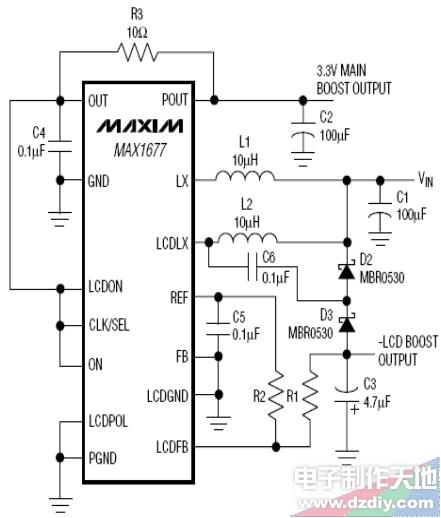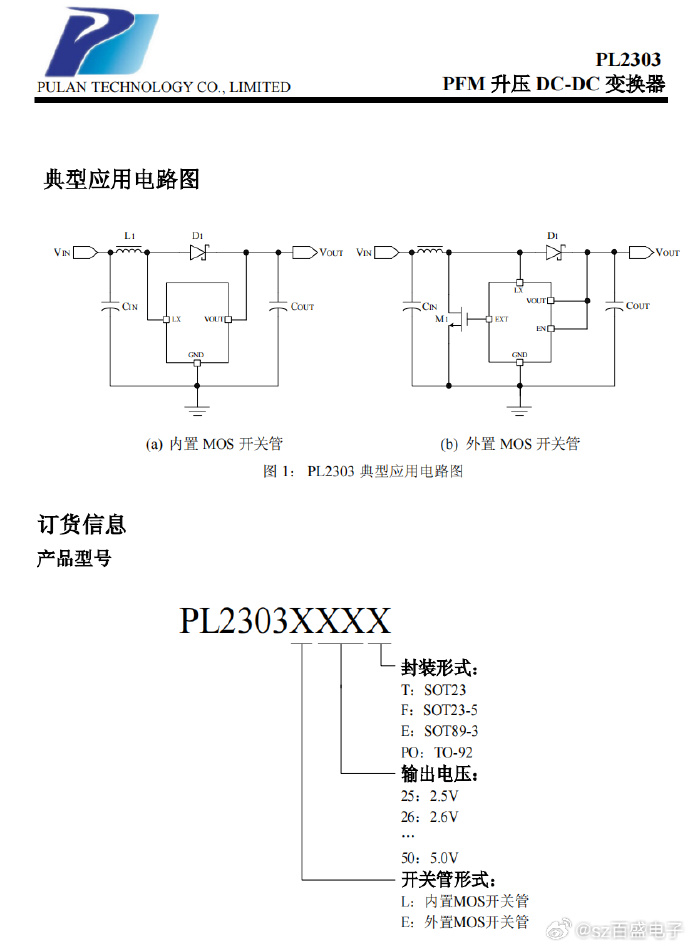MAX1677 dc-dc直流升压变换器,MAX1677 Dual-Output Step-Up and LCD Bias DC-DC Converter
关键字:MAX1677 dc-dc直流升压变换器
简介:
The MAX1677 is a compact, high-efficiency, dual-output boost converter for portable devices needing two regulated supplies, typically for logic and liquid crystal displays (LCDs). Operation with inputs as low as 0.7V allows the MAX1677 to accept 1, 2, or 3-cell alkaline, NiCd, or NiMH batteries as well as 1-cell lithium-ion batteries. The device requires no external FETs and can maintain regulation while consuming only 20µA, making it ideal for hand-held pen-input and PDA devices operating with low-current "sleep" states.
The MAX1677's primary regulator supplies up to 350mA at either a factory-preset 3.3V or an adjustable 2.5V to 5.5V output. On-chip synchronous rectification provides efficiencies up to 95%. 300kHz (or externally clocked) pulse-width-modulation (PWM) operation is particularly suitable for applications needing low noise, such as those with wireless features. The primary converter also features pin-selectable pulse-frequency-modulation (PFM) operation that consumes only 20µA. A 1µA shutdown state also minimizes battery drain.
The MAX1677's secondary step-up converter supplies up to +28V or -28V for LCD bias, varactor tuning, or other high-voltage, low-current functions. Other MAX1677 features include precision reference, logic control inputs for both regulators, and an uncommitted comparator for low-battery detection or a reset function. The MAX1677 is supplied in Maxim's compact 16-pin QSOP package, which occupies no more space than a standard SO-8.
The MAX1677's primary regulator supplies up to 350mA at either a factory-preset 3.3V or an adjustable 2.5V to 5.5V output. On-chip synchronous rectification provides efficiencies up to 95%. 300kHz (or externally clocked) pulse-width-modulation (PWM) operation is particularly suitable for applications needing low noise, such as those with wireless features. The primary converter also features pin-selectable pulse-frequency-modulation (PFM) operation that consumes only 20µA. A 1µA shutdown state also minimizes battery drain.
The MAX1677's secondary step-up converter supplies up to +28V or -28V for LCD bias, varactor tuning, or other high-voltage, low-current functions. Other MAX1677 features include precision reference, logic control inputs for both regulators, and an uncommitted comparator for low-battery detection or a reset function. The MAX1677 is supplied in Maxim's compact 16-pin QSOP package, which occupies no more space than a standard SO-8.
特性:
- No External FETs Required
- Main Output
- Up to 350mA for Logic Supply
- Fixed 3.3V or Adjustable (2.5V to 5.5V)
- Synchronous Rectification for High Efficiency (up to 95%)
- 300kHz (200kHz to 400kHz Synchronizable)
- Fixed-Frequency PWM Operation
- Secondary Output
- Up to +28V or -28V for LCD Bias
- Programmable Current Limit
- 0.7V to 5.5V Input Voltage Range
- 20µA Quiescent Current
- 1µA Shutdown Current
- Low-Battery Comparator
- Small 16-Pin QSOP Package
引脚介绍:

应用:
正压输出电路LCD Converter in Positive Mode:

LCDFB的基准电压:1.25V
负压输出电路LCD Converter in Negative Mode:

DOWMLOAD DATASHEET: http://datasheets.maxim-ic.com/en/ds/MAX1677.pdf
声明:本文内容及配图由入驻作者撰写或者入驻合作网站授权转载。文章观点仅代表作者本人,不代表电子发烧友网立场。文章及其配图仅供工程师学习之用,如有内容侵权或者其他违规问题,请联系本站处理。
举报投诉
发布评论请先 登录
相关推荐
DC-DC直流升压模块的选型
大家好,我在一个项目中需要将低电压(如5V或3.7V)升压至3KV及以上,系统功率大约为1W。由于我对DC-DC直流升压模块的选型及实施不太熟悉,特此请教各位高手,希望能得到以下方面的
发表于 11-29 11:05
DC-DC变换器是什么意思
DC-DC变换器,即直流-直流变换器,是一种在直流电路中将一个电压值的电能转换为另一个电压值的电能的装置。它广泛应用于各种电子设备中,特别是
DC-DC升压模块的工作原理
DC-DC升压模块的工作原理是一个复杂但高效的过程,它基于电感器的能量存储和释放机制,通过开关器件的快速通断来实现电压的升高。以下是对DC-DC升压
DC-DC 和LDO 简单介绍
限制了其只能实现降压功能,因此它无法完成升压操作。
DC-DC: BUCK/BOOST型DC-DC既可用于降压,也可用于升压.
LDO参考设计电路:
发表于 06-03 14:53
DC-DC变换器为低压蓄电池充电的条件是?
在现代电子设备供电系统中,DC-DC变换器发挥着至关重要的作用。尤其是在可充电电池应用中,DC-DC变换器不仅负责提供稳定的直流电源,还承担
DC-DC_升压稳压变换器设计
DC-DC功率变换器的种类很多。按照输入/输出电路是否隔离来分,可分为非隔离型和隔离型两大类。非隔离型的DC-DC变换器又可分为降压式、升压
发表于 01-30 11:45
•6次下载
DC-DC转换器电路图 Boost升压型DC-DC转换器的工作原理
DC-DC转换器电路图 Boost升压型DC-DC转换器的工作原理
Boost升压型
如何选择正确的TVS与DC-DC
在汽车电源系统中,DC-DC(直流-直流)变换器的损坏可能由多种因素引起。然而,其中一个主要原因是浪涌TVS(过压保护器)的残压过高。为确保
发表于 01-06 11:24
•500次阅读





 MAX1677 dc-dc直流升压变换器,MAX1677 Dual-Output Step-Up and LCD Bias DC-DC Converter
MAX1677 dc-dc直流升压变换器,MAX1677 Dual-Output Step-Up and LCD Bias DC-DC Converter














评论